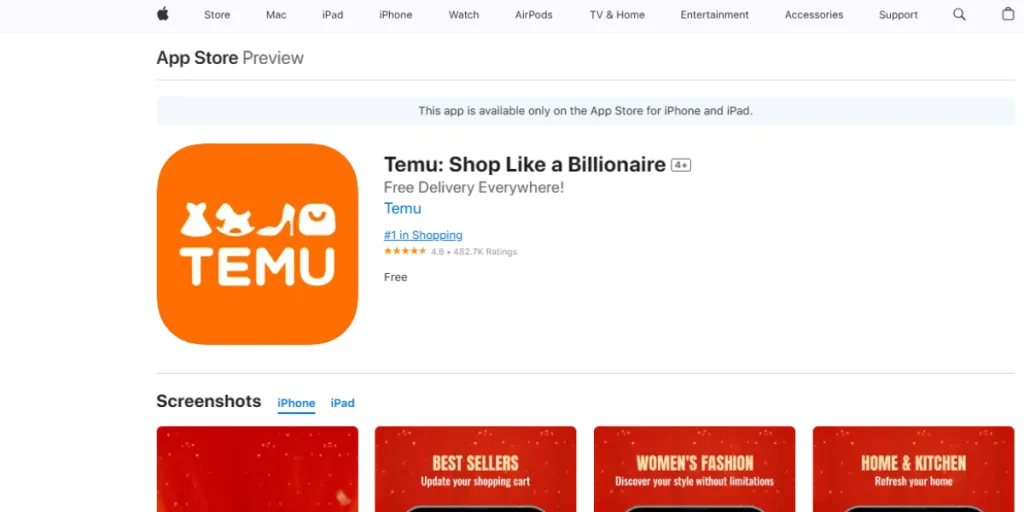Temu was the number 1 most downloaded app on the Android App Store and Google Play in many countries, including the US, UK, France, Germany, Italy, Australia, and South Korea. With over 74 million downloads by July 2023 alone, Temu’s success over such a short amount of time is nearly unprecedented. But where does its incredible appeal come from: the selling of endless cheap goods, or is it something deeper?
Read on as we look at the strategies Temu has employed to become the ecommerce phenomenon it is today.
Table of Contents
What is Temu and how did it establish its brand name
Factors leading to Temu’s super-cheap pricing
Temu’s revenue strategy
Temu: Too good or too cheap to last?
What is Temu and how did it establish its brand name
Temu, a part of PDD Holdings, the third-largest ecommerce giant in China, was launched to meet U.S. consumer needs with potential global expansion. Since its inception in September 2022, Temu saw an explosion in popularity, especially after its memorable Super Bowl advertisement that ran twice in January 2023, featuring the slogan “Shop like a billionaire.”
As an online shopping website and app, Temu is “committed to offering the most affordable quality products,” according to its mission statement, featuring cut-throat low prices and drawing shoppers through effective use of social media and data analytics.
Temu’s rapid growth is largely hinged on being able to meet consumer demands in the following ways:
Offering incredibly low prices

Despite their bold, enticing billionaire-style slogan, Temu isn’t a haven for billionaire shoppers. Far from it, in fact, being instead a shopping platform targeted at price-savvy bargainers.
In effect, Temu practically offers low prices on all sorts of products. Think $1 mini laptop microphones and $10 ultra-thin Bluetooth keyboards to $2 sunscreens and various sub-$1 lightning deals that include some otherwise noticeably pricier products such as lip balm and assorted makeup tools.
Oriented toward social shopping

Temu’s strategy goes beyond regular influencer marketing by making every user, especially new ones, an “influencer.” They do this by encouraging users to share Temu’s referral codes on social media. In return, users earn referral bonuses and credits, usable for shopping on Temu or convertible to cash via PayPal. Those referred also get benefits, like coupons for discounts. This innovative approach has been key to making Temu the most downloaded app in various countries.
Prolific adoption of data analytics and AI
Temu leverages data analytics and artificial intelligence for its operations, enhancing the shopping experience for its users. Customers receive personalized recommendations based on their purchase history, preferences, and searches. This approach mirrors that of its parent company, aligning China’s production capacity with global demand. Such technology deployment is key to Temu’s ability to offer a wide range of products at attractively low prices.
Factors leading to Temu’s super-cheap pricing
As it turns out, while the extremely low prices on Temu have managed to win the hearts of millions of consumers, many can’t help but wonder how such low prices are achieved. So, let’s take a look at some of the factors that contribute to those seemingly irresistible offers:
Financial and parent company backing
What’s the easiest way to become a millionaire? Answer: to be born to billionaire parents.
Jokes aside, there’s a certain element of truth to this in Temu’s case. Backed by its parent company, PDD Holdings, Temu benefits from vast financial resources and ecommerce expertise. In 2023 alone, PDD allocated a $1 billion marketing budget to promote Temu.
This figure, though, merely represents a drop in the ocean for the well-off parent company, whose market capitalization was estimated to be $153 billion in 2023. Temu’s strategy involves providing the lowest prices on its platform, a tactic similar to Pinduoduo’s approach in China. This method, coupled with Pinduoduo’s network and efficient supply chain, helps Temu dominate the market.
Made in China origin
With its China origin, it may sound pretty intuitive for Temu to export in the majority of its products from China directly. Yet in order to attain greater pricing leverage, Temu not only sources most of its hosted products from the “world’s factory” but also innovatively includes manufacturers directly in its seller network. This approach allows consumers to order products directly from these factories through their phones or laptops. The result? Online shoppers bypass middlemen and get much larger discounts on a wide range of products.
Pricing and cost-cutting strategies

Temu has balanced price reduction with cost-saving strategies to increase its market share. By adopting minimalistic packaging and focusing on social marketing, the company effectively cuts costs. Key strategies include referral programs, affiliate collaborations, and its unique “campus ambassador” program. These initiatives allow nearly anyone to earn commissions, significantly reducing Temu’s advertising expenses.
Benefits from international trade policies
Certain international trade policies have also fortuitously benefitted Temu. For instance, Temu benefits from the “de minimis” rule under U.S. federal law, which allows the import of items into the U.S. without customs duties or taxes if their total retail value in a day is less than $800. This policy is especially cost-effective for businesses importing small quantities of low-value items, fitting Temu’s operational model perfectly.
Temu’s revenue strategy
In a nutshell, the Temu’s revenue strategy is designed to complement its atypical, remarkably-low-pricing approach, creating a synergistic effect to make a more cohesive financial policy. Here are a few evident examples:
Economic benefits of scale and bulk trading
Temu’s price reduction strategy is not just for attracting customers but also aims to achieve economies of scale. As more people purchase Temu’s low-price offers, the company’s costs decrease. To enhance this, Temu uses bulk purchasing and negotiated supplier contracts. These methods, along with longer credit terms with suppliers and advance payments from customers, help Temu improve its cash flow and reach economies of scale.
Fully managed model
- Full autonomy of profit margins
Temu adopts a “fully managed” (全托管) approach with its China sellers, meaning neither the seller nor the buyer pays for completed transactions. This aligns with its low-pricing policy to boost buyer involvement. Under this model, suppliers ship goods directly to Temu’s central warehouse, so the platform doesn’t charge them shipping or transactional fees. Temu earns by setting its own margins on these price differences, which provides Temu with the utmost flexibility and authority in setting its preferred margin level.
This “fully managed” model is also used by AliExpress, Lazada, Shopee, and, more recently, TikTok Shop. AliExpress, a pioneer in this approach, launched their fully managed system just three months after Temu and has seen encouraging initial results.
- Strengthened bargaining position
Temu’s fully managed service framework boosts its bargaining power with suppliers, especially among small and medium merchants who appreciate the focus on product quality and sales. This approach is seen as hassle-free and scalable, attracting more suppliers and thus strengthening Temu’s bargaining position. As a result, Temu benefits from better pricing, extended credit terms, and an improved product sourcing process, enhancing overall product quality.
Temu: Too good or too cheap to last?

Temu, famous for its extremely low prices, has quickly risen to prominence in the ecommerce world. However, this rapid growth has been marred by controversies, including reports of forced labor and evidence of financial instability. There’s no doubt that it has successfully blended AI-enhanced social shopping with strategic pricing and expansion, yet questions about its sustainability linger. These include factors like support from its parent company, direct manufacturer relationships in China, and global trade policies.
To maintain financial health, Temu uses a fully managed model where it controls margins and profits from transactional price differences. This model appeals to many sellers as it simplifies business operations. It also boosts Temu’s bargaining power with suppliers, allowing it to negotiate better terms on pricing, credit duration, and product quality. Such a strategy positions Temu for potential future growth, despite existing challenges.
For more trade solutions, industry dynamics, and fresh perspectives on business ideas, make sure to subscribe to Alibaba.com Reads.




